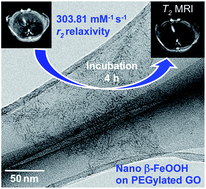β-FeOOH has shown promise as a new contrast agent in magnetic resonance imaging (MRI), however, sensitive and accurate MR imaging is largely limited by its low transverse relaxivity (r2). Herein, for the first time we report in situ growth of β-FeOOH nanorods onto PEGylated graphene oxide (GO) sheets to produce a nanocomposite, e.g., GO-PEG–β-FeOOH. This nanocomposite exhibits a record ultra-high transverse relaxivity (r2) value of 303.81 mM−1 s−1, that is, >60 times higher than those achieved by hitherto reported β-FeOOH based MRI contrast agents. This well facilitates its practical use as a contrast agent for in vivo MR imaging. PEG on the surface of the GO nanocomposite improved the colloidal stability in aqueous medium. In addition, in vitro cell viability tests demonstrated that GO-PEG–β-FeOOH has minimal cellular toxicity. GO-PEG–β-FeOOH has been used for loading doxorubicin hydrochloride (DOX) with a capacity of 1.35 mg mg−1, which exhibits high efficiency in Hela cell apoptosis. These results indicated that GO-PEG–β-FeOOH provides an effective alternative to the existing nanoparticle-based contrast agents for non-invasive in vivo MR imaging and cancer therapy.

You have access to this article
 Please wait while we load your content...
Something went wrong. Try again?
Please wait while we load your content...
Something went wrong. Try again?


 Please wait while we load your content...
Please wait while we load your content...